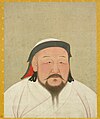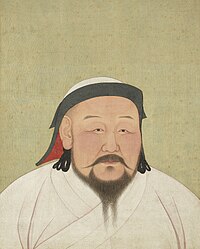پەڕگە:YuanEmperorAlbumKhubilaiPortrait.jpg

قەبارەی ئەم پێشبینینە: ٤٨٠ لە ٥٩٩ پیکسەڵ. ڕێزەلووشنەکانی تر: ١٩٢ لە ٢٤٠ پیکسەڵ | ٣٨٥ لە ٤٨٠ پیکسەڵ | ٦١٦ لە ٧٦٨ پیکسەڵ | ٨٢١ لە ١٬٠٢٤ پیکسەڵ | ١٬٦٤٢ لە ٢٬٠٤٨ پیکسەڵ | ٣٬٢٢١ لە ٤٬٠١٨ پیکسەڵ.
پەڕگەی سەرەکی (٣٬٢٢١ × ٤٬٠١٨ پیکسڵ، قەبارەی پەڕگە: ١٣٫٠٢ مێگابایت، جۆری ئێم ئای ئێم ئی: image/jpeg)
مێژووی پەڕگە
کرتە بکە لەسەر یەکێک لە ڕێکەوت/کاتەکان بۆ بینینی پەڕگەکە بەو شێوەی لەو کاتەدا بووە.
| ڕێکەوت/کات | ھێما | ئەندازە | بەکارھێنەر | تێبینی | |
|---|---|---|---|---|---|
| هەنووکە | ١١:١٩، ٢١ی کانوونی یەکەمی ٢٠٢٢ |  | ٣٬٢٢١ لە ٤٬٠١٨ (١٣٫٠٢ مێگابایت) | Kcx36 | higher resolution |
| ١٢:٤٦، ٢٤ی شوباتی ٢٠٢١ |  | ٢٬٦٧٨ لە ٣٬٢٠٠ (٩٦٧ کیلۆبایت) | CAPTAIN MEDUSA | higher res | |
| ٠٠:٠٣، ١٣ی تشرینی یەکەمی ٢٠١٦ |  | ١٬٣٣٩ لە ١٬٦٠٠ (١٫٥٤ مێگابایت) | Eugene a | True color | |
| ١٨:٠٤، ٧ی کانوونی یەکەمی ٢٠١٠ |  | ٨٦٤ لە ١٬٠٧٧ (١٢٣ کیلۆبایت) | Eugene a | Best version | |
| ١٨:٢١، ٢٥ی تشرینی دووەمی ٢٠١٠ |  | ٤٨٠ لە ٦١٨ (١٢٠ کیلۆبایت) | Dirrival | a better version | |
| ٠٤:٤٣، ٣٠ی ئەیلوولی ٢٠١٠ |  | ٥١٧ لە ٦٤٠ (٦٨ کیلۆبایت) | Wmpearl | ||
| ١٤:٠٣، ٢٨ی ئایاری ٢٠٠٨ |  | ٨٧٧ لە ١٬١٠٣ (١٦١ کیلۆبایت) | Yaan | == Summary == {{Information |Description = Shizu, better known as Khubilai. Portrait cropped out of a page from an album depicting several Yuan emperors (Yuandai di banshenxiang), now located in the National Palace Museum in Taipei (inv. nr. zhonghua 0003 |
بەکارھێنانی پەڕگە
ئەم پەڕەیە ئەم پەڕگەیە بەکار دەھێنێت:
بەکارھێنانی سەرانسەریی پەڕگە
ئەم ویکیانەی دیکەی خوارەوەش ئەم پەڕگە بەکاردێنن:
- بەکارھێنان لە af.wikipedia.org
- بەکارھێنان لە als.wikipedia.org
- بەکارھێنان لە ang.wikipedia.org
- بەکارھێنان لە an.wikipedia.org
- بەکارھێنان لە ar.wikipedia.org
- قوبلاي خان
- ويكيبيديا:في هذا اليوم/5 مايو
- إمبراطورية المغول
- بوابة:أعلام/صورة مختارة/أرشيف
- ويكيبيديا:صور مختارة/فنون/منمنمات
- بوابة:الإمبراطورية المغولية/شخصية مختارة
- بوابة:الإمبراطورية المغولية/شخصية مختارة/أرشيف
- بوابة:الإمبراطورية المغولية/شخصية مختارة/1
- ويكيبيديا:في هذا اليوم/مايو
- فن صيني
- ويكيبيديا:ترشيحات الصور المختارة/قوبلاي خان
- ويكيبيديا:صورة اليوم المختارة/مارس 2021
- قالب:صورة اليوم المختارة/2021-03-29
- بوابة:أعلام/صورة مختارة/42
- الحرب الأهلية التولوية
- ويكيبيديا:صورة اليوم المختارة/سبتمبر 2022
- قالب:صورة اليوم المختارة/2022-09-23
- بەکارھێنان لە ar.wikinews.org
- بەکارھێنان لە arz.wikipedia.org
- بەکارھێنان لە ast.wikipedia.org
- بەکارھێنان لە azb.wikipedia.org
- بەکارھێنان لە az.wikipedia.org
- بەکارھێنان لە ba.wikipedia.org
بینینی بەکارھێنانی گشتی زیاتری ئەم پەڕگەیە.



